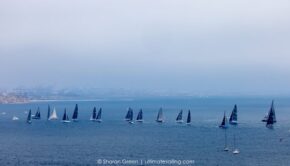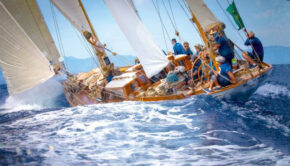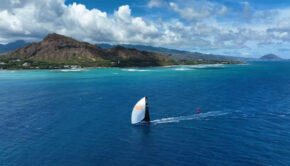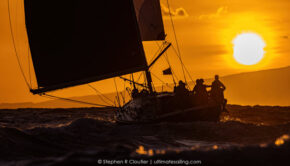Dorade: “A kind of awakening” for yachting design
Published on July 29th, 2013
The 83 year old Dorade is enjoying a renaissance. Her new owners, Matt Brooks and his wife Pam Rorke Levy (or, as they describe themselves, the “current caretakers”) have invested in numerous renovations and upgrades to fulfill their dream of entering her in all the races she won in her early life.
While her recent victory – overall winner of the 2013 Transpac Race – may set expectations too high, it is her history that will forever maintain her winning reputation. Author Bruce Knecht shares a glimpse of her past and the man for whom will always be associated with…
Olin Stephen’s obsession with sailboats took hold shortly after World War I during a childhood visit to Cape Cod. He didn’t just admire them. He studied them with what he later described as “great concentration,” sketching and photographing any he thought might be worth emulating, and imagining how he might do things differently.
By the time he was 20, Stephens had dropped out of M.I.T., had brief apprenticeships with several leading yacht designers, drawn up plans for a handful of relatively small boats, and formed his own company, Sparkman & Stephens. On the basis of his early promise, his father, who had recently sold his retail coal supply business, placed an order for a much larger yacht that was completed in 1930. Dorade, the 52-foot yawl (named for a speedy dolphin that is correctly spelled Dorado) was revolutionary.
Most obviously, it was strikingly slender, its beam just 10’3”. It was also extremely lightweight, in part because the frames were made from steam-bent sections of wood weighing far less than the conventional and much bulkier sawn ones. Until then, it was believed that ocean-going stability could only be achieved with a much broader and heavier hull. Stephens overcame that with a deal lead keel, which meant the ballast was positioned far below the waterline rather than in the hull. Thanks to its narrowness and lightweight, Stephens was certain Dorade would be fast. It was also strikingly beautiful. Its bow and stern rise from the water with curvaceous grace, creating the elegant overhangs that are hallmarks of classic sailing yachts.
But Dorade represented a major risk. Without the computer analysis and tank testing that is now commonplace, Stephens created a radical new design by trusting his instinctive sense for how a vessel’s lines would affect its performance. The lack of precise analysis was obvious the moment the boat was launched: the waterline that had been painted on the side of the hull was three inches below the surface of the water. When Stephens announced that he was going to enter it in a transatlantic race that would set out from Newport on July 4, 1931, many yachtsmen thought he was foolhardy.
Stephens was the skipper and navigator during the race. His seven-man crew, which included his brother Rod, who had overseen the yacht’s construction, was young: even with the Stephens’ 46-year-old father, the average age was 22.
Olin Stephens was at the helm when Dorade crossed the line on July 31. Longer sailboats generally go faster than shorter ones, but Dorade, the third smallest member of the ten-yacht fleet, reached the finish line two days before the second-place boat. When the time was “corrected” to reflect the differences among the yachts, Dorade’s time was almost four days better than its closest rival. Dorade went on to win the Fastnet Race by a wide margin. When the crew returned to New York City, where Sparkman & Stephens had its office, they were rewarded with a ticker-tape parade, a first for yachtsmen.
Yacht design has never been the same. The assumptions that had limited designer to incremental advances were abandoned and the modern age of racing design commenced. No one benefited from this more than Stephens who became the most successful yacht designer of the 20th Century, creating plans for six successful America’s Cup defenders.
Famously modest, Stephens, who passed away in 2008 at 100 years, had been reluctant to rate Dorade as a masterpiece. He said it was too narrow, that it would have gone even faster, and be less “rolly,” if he had given it a bit more breadth. But when I spoke to him shortly before he died, he acknowledged that Dorade was a breakthrough, or, as he put it, “a kind of awakening,” for yachting design. “I knew that a lighter boat with outside ballast was the way to go, and that a deep and narrow hull would go through the sea nicely. It was obvious. It was like taking candy from a baby. It just had to win.”








 We’ll keep your information safe.
We’ll keep your information safe.